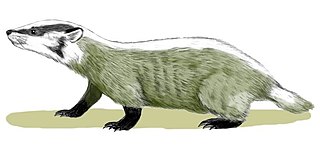
Proailurus is an extinct felid genus that lived in Europe and Asia approximately 25-30.8 million years ago in the Late Oligocene and Miocene. Fossils have been found in Mongolia, Germany, and Spain.

Tapirus is a genus of tapir which contains the living tapir species. The Malayan tapir is usually included in Tapirus as well, although some authorities have moved it into its own genus, Acrocodia.

Aelurodon is an extinct canid genus of the subfamily Borophaginae which lived from the Barstovian land mammal age of the middle Miocene to the late Miocene epoch. Aelurodon existed for approximately 10.7 million years.

Epicyon is a large, extinct, canid genus of the subfamily Borophaginae, native to North America. Epicyon existed for about 15 million years from the Hemingfordian age of the Early Miocene, to the Hemphillian of the Late Miocene. Epicyon is the largest known canid of all time, with the type species reaching 2.4 m (7.9 ft) in length, 90 cm (35 in) in shoulder height and approximately 100–125 kg (220–276 lb) in body mass. The largest known humerus specimen belonged to an individual weighing up to 170 kg (370 lb).

The Antilocapridae are a family of artiodactyls endemic to North America. Their closest extant relatives are the giraffids. Only one species, the pronghorn, is living today; all other members of the family are extinct. The living pronghorn is a small ruminant mammal resembling an antelope.

Cosoryx is an extinct genus of antilocaprid that lived in the Miocene of Nevada. Fossils of this genus have also been found in the Santa Fe Group in New Mexico.

Hayoceros is an extinct genus of the artiodactyl family Antilocapridae, endemic to North America during the Pleistocene epoch, existing for about 1.5 million years.

Chamitataxus is a prehistoric badger genus. Chamitataxus avitus is the only known species of the genus. Chamitataxus lived during the Late Miocene, around 6 million years ago in what is now North America. Out of the three taxideine badger genera to have existed on the continent, Chamitataxus is the most primitive. Very few taxideine badger remains have been uncovered to date, with only prehistoric Taxidea and Pliotaxidea specimens being discovered prior to the Chamitataxus holotype being found.

Rhynchotherium is an extinct genus of proboscidea endemic to North America and Central America during the Miocene through Pliocene from 13.650 to 3.6 Ma, living for approximately 10 million years.

Ramoceros is an extinct genus of the artiodactyl family Antilocapridae endemic to Middle Miocene (Clarendonian) North America.
Synthetoceratinae is an extinct subfamily of Protoceratidae, deer-like herbivorous mammals belonging to the order Artiodactyla. They were endemic to North America during the Miocene epoch, living 23.03—3.9 Ma, existing for approximately 19.13 million years.

Merycodus is an extinct genus of the artiodactyl family Antilocapridae. Fossils of this genus have been found in the Santa Fe Group of New Mexico.
Brontochelys is an extinct genus of podocnemidid from the Miocene of Pakistan. The only species known, B. gaffneyi was classified before in the genus Shweboemys, which is known from the Pliocene of Burma. Brontochelys is represented only by its type specimen BMNH R.8570, a nearly complete skull, which exact locality is unknown but probably comes from the Lower Miocene sediments in the Bugti Hills, in Baluchistan, Pakistan. This skull is different from its relatives like Shweboemys, Lemurchelys and Stereogenys by its large, forward-faced orbits, a large frontal bone that composes most of the dorsal orbit margin and a palatal curved. The name of Brontochelys is formed by the Greek words bronte, "thunder" and chelys, "turtle", in reference to the large size of the skull.
Kinosternon pojoaque is an extinct turtle in the genus Kinosternon. It existed in what is now New Mexico, United States, during the Middle Miocene period. It was described by Jason R. Bourque in 2012.

The Chamita Formation is a geologic formation in north-central New Mexico. It preserves unique fossils dating back to the Neogene period. The presence of volcanic ash beds in the formation, which can be radiometrically dated, gives the absolute age of the fossils, which is valuable for establishing the geologic time scale of the Neogene.

The Tesuque Formation is a geologic formation in north-central New Mexico, United States. The formation provides an unusually complete record of the evolution of mammals during the Miocene epoch.

Lophocetus is an extinct genus of dolphin belonging to the clade Delphinida that is known from late Miocene (Tortonian) marine deposits in California and Maryland. Although usually placed in Kentriodontidae, recent studies have found it only distantly related to Kentriodon.

Merriamoceros is an extinct genus of pronghorn. It is known from a single species, which is also the type species, M. coronatus.

Capromeryx was a genus of dwarf pronghorns (Antilocapridae) that originated in North America during the Pliocene about 5 million years ago. The closest living relative and only surviving member of the family is the North American pronghorn.

The Santa Fe Group is a group of geologic formations in New Mexico and Colorado. It contains fossils characteristic of the Oligocene through Pleistocene epochs. The group consists of basin-filling sedimentary and volcanic rocks of the Rio Grande rift, and contains important regional aquifers.

















